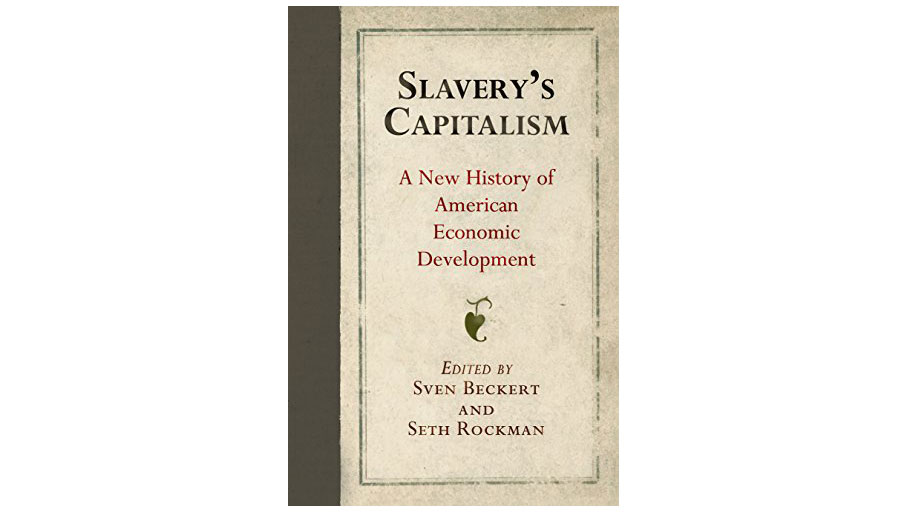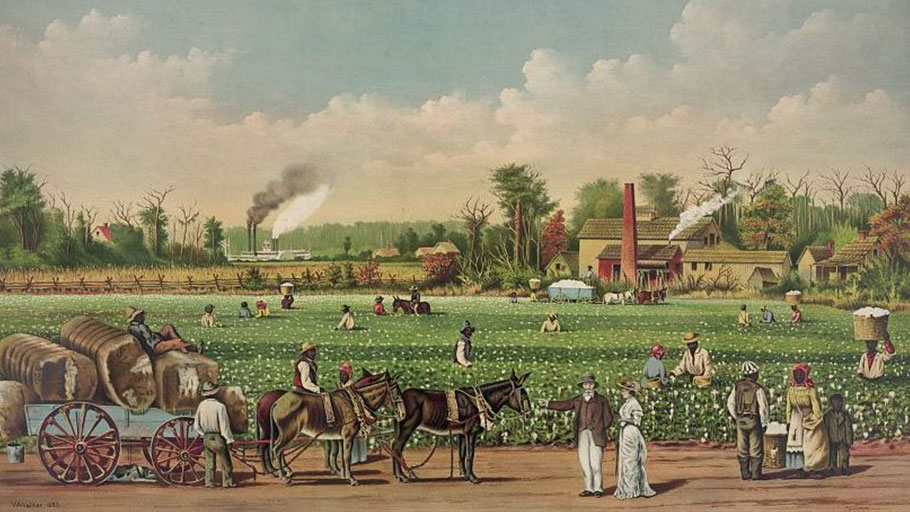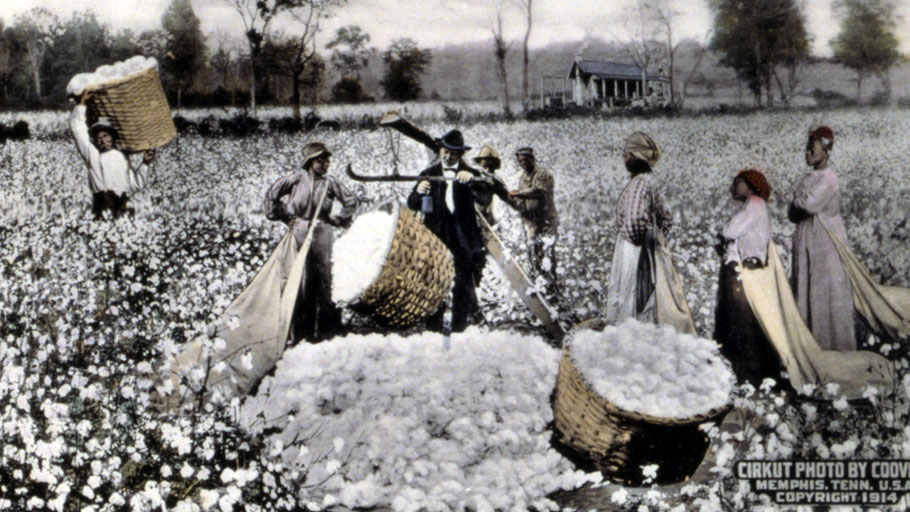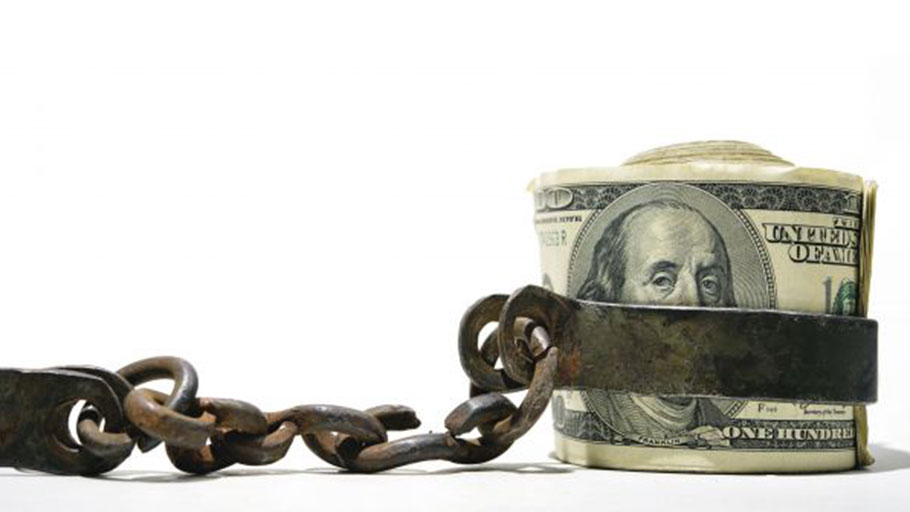By Dina Gerdeman, Forbes —
The ties between slavery and capitalism in the United States weren’t always crystal clear in our history books. For a long time, historians mostly depicted slavery as a regional institution of cruelty in the South, and certainly not the driver of broader American economic prosperity.
Now 16 scholars are helping to set the record straight by exploring the true ties between 19th century economic development and a brutal system of human bondage in the 2016 book Slavery’s Capitalism: A New History of American Economic Development.
 Contrary to popular belief, the small farmers of New England weren’t alone responsible for establishing America’s economic position as capitalism expanded. Rather, the hard labor of slaves in places like Alabama, South Carolina, and Mississippi needs to be kept in view as well. In fact, more than half of the nation’s exports in the first six decades of the 19th century consisted of raw cotton, almost all of it grown by slaves, according to the book, which was edited by Sven Beckert, the Laird Bell Professor of History at Harvard University and visiting professor at HBS, as well as Seth Rockman, Associate Professor of History at Brown University.
Contrary to popular belief, the small farmers of New England weren’t alone responsible for establishing America’s economic position as capitalism expanded. Rather, the hard labor of slaves in places like Alabama, South Carolina, and Mississippi needs to be kept in view as well. In fact, more than half of the nation’s exports in the first six decades of the 19th century consisted of raw cotton, almost all of it grown by slaves, according to the book, which was edited by Sven Beckert, the Laird Bell Professor of History at Harvard University and visiting professor at HBS, as well as Seth Rockman, Associate Professor of History at Brown University.
The slave economy of the southern states had ripple effects throughout the entire U.S. economy, with plenty of merchants in New York City, Boston, and elsewhere helping to organize the trade of slave-grown agricultural commodities—and enjoying plenty of riches as a result.
“In the decades between the American Revolution and the Civil War, slavery—as a source of the cotton that fed Rhode Island’s mills, as a source of the wealth that filled New York’s banks, as a source of the markets that inspired Massachusetts manufacturers—proved indispensable to national economic development,” Beckert and Rockman write in the introduction to the book. “… Cotton offered a reason for entrepreneurs and inventors to build manufactories in such places as Lowell, Pawtucket, and Paterson, thereby connecting New England’s Industrial Revolution to the advancing plantation frontier of the Deep South. And financing cotton growing, as well as marketing and transporting the crop, was a source of great wealth for the nation’s merchants and banks.”
We asked Beckert—who researches and teaches the history of US capitalism in the 19th century—to discuss the book and to talk about what lessons today’s business leaders can learn from the past.
Dina Gerdeman: The book makes note of the fact that a myth existed for many years: that slavery was “merely a regional institution, surely indispensable for understanding the South, but a geographically confined system of negligible importance to the nation as a whole.” Why do you think for so many years historians made slavery out to be a “southern problem” and didn’t seem to make a strong connection between slavery and things like innovation, entrepreneurship, and finance, which are at the heart of American capitalism?
Sven Beckert: This is an excellent question, and indeed, as you note, quite puzzling. It is puzzling for three reasons: For one, into the early years of the 19th century, slavery was a national institution, and while slavery was never as predominate a system of labor in the North as it was in the South, it was still important.
Second, there were a vast number of very obvious economic links between the slave plantations of the southern states and enterprises as well as other institutions in the northern states: Just think of all these New York and Boston merchants who traded in slave-grown goods. Or the textile industrialists of New England who processed vast quantities of slave-grown cotton. Or the bankers who financed the expansion of the plantation complex.
And third, both the abolitionists as well as pro-slavery advocates talked over and over about the deep links between the southern slave economy and the national economy.
Why did these insights get lost? I think the main reason is ideological and political. For a long time after the Civil War, the nation really did not want to be reminded of either the war or the institution that lay at its root—slavery. A country that saw itself as uniquely invested in human freedom had a hard time coming to terms with the centuries’ long history of enslaving so many of its people.
When slavery became more important to our historical memory, especially in the wake of the Civil Rights movement of the 1950s and 1960s, the work of reconciling the history of freedom and the history of enslavement involved quarantining the history of slavery to one section of the nation only. That allowed for doing two things simultaneously: It allowed for the belated acknowledgement of the importance, barbarity, and longevity of slavery in the United States. But it also allowed for a continued telling of the story of freedom, since the national story could be told as one in which one section of the United States, the North, fought hard to overcome the retrograde, coercive, and inhumane system of slavery in the other section.
Of course, this story is not completely wrong. Yet what it effectively did was to insulate the national story from the problem of slavery. A focus on the economic links generated around slavery, the story that our book charts, brings the story of enslavement squarely back into the center of the national history as a whole. And this is where it belongs.

A cotton plantation on the Mississippi, 1884
Gerdeman: The book says “the relationship of slavery to American capitalism rightfully begins on the plantation.” Can you explain how the North benefited from the slave-grown cotton in the South? And how did this “empire of cotton” help create modern capitalism?
Beckert: There are very many economic links between the southern plantation complex and the development of American and global capitalism, involving trade, industry, banking, insurance, shipping, and other industries. The most prominent link developed around cotton.
As you know, the cotton industry was crucial to the world-altering Industrial Revolution as it first unfolded in Great Britain and then spread from there to other parts of the world, including the northern states of the Union. Until 1861, until the American Civil War, almost all cotton used in industrial production was grown by enslaved workers in the southern parts of the United States. Slavery thus played a very important role in supplying an essential raw material for industrial production.
Yet there were further links: British and later U.S. capital financed the expansion of the slavery complex in the American South. Advancing credit was essential for southern planters to be able to purchase land and labor. Northern merchants, moreover, organized the shipment of cotton into global markets.
And of course northern manufacturers, along with their European counterparts, supplied plantations in the South with tools, textiles, and other goods that were necessary to maintain the plantation regime. Plantation slavery, far from being a retrograde system on its way to being ousted by industrial capitalism, saw a second flourishing in the 19th century in the wake of the industrial revolution. And in the United States, cotton was central to that “second slavery.”
 Gerdeman: Some argued that with the abolition of slavery, the North was poised to “kill the goose that has laid their golden egg.” Can you explain why that wasn’t the case?
Gerdeman: Some argued that with the abolition of slavery, the North was poised to “kill the goose that has laid their golden egg.” Can you explain why that wasn’t the case?
Beckert: Slavery was important to a particular moment in the history of capitalism. But there were also severe tensions between the deepening and spread of capitalism and slavery.
For one, slavery was quite unstable. Slaves resisted their enslavements, and slave owners needed to deploy a lot of violence, coercion, and oversight to ensure the stability of the plantation and slave society more broadly. Moreover, slavery did not satisfy the labor needs that emerged in modern industrial enterprises; very little slave labor was used there.
And last but not least, slave owners had a very definite idea about the political economy of the United States, focused on the export of agricultural commodities to world markets, free trade, and the territorial expansion of the slave regime into the American West. That was quite distinct from the increasingly urgent and also powerful political needs of northern industrialists and bankers. They wanted tariff protection and the expansion of free labor into the American West. Both these political economies depended on the control of the federal government.
With the advent of the Republican Party and then especially with the 1860 election of Abraham Lincoln to the presidency, that control became uncertain. As a result, southerners struck out on their own, provoking a violent Civil War that was won by the forces opposed to slavery.
Gerdeman: Do you think today’s business executives could learn any important lessons from this new understanding of the connection between slavery and the American market?
Beckert: Yes, definitely. The most important lesson this history provides is that business leaders whose companies’ history goes back into the antebellum era need to be proactively researching this history and confronting it. No one alive today is responsible for slavery—a crime against humanity. But we all need to face our histories and then try to move forward from that acknowledgement of the past.
More generally, it is crucially important that companies have a full understanding of their supply chains and of the labor conditions that are to be found throughout these chains. If they violate fundamental human rights, companies have the responsibility and also the ability to act.
There were powerful business interests in the 19th century who worked diligently against slavery. Just think of the Tappan brothers of New York, merchants who combined their business with anti-slavery activism. And then there were also entrepreneurs who refused to process slave-grown cotton. These people can serve as examples of what is possible. They show that to have a full understanding of all aspects of one’s business and to aggressively enforce fundamental human norms and rights is possible and necessary.
When you read the letters of businessmen of the 1840s and 1850s, you see numerous efforts to separate business and morality into distinct realms. Merchants and manufacturers in the past did know that slavery was a moral problem, but then they tried to say that such moral considerations were extraneous to the concerns of business. In retrospect we can all agree that these claims are preposterous. Such observations should make everyone today acutely conscious about making rationalizations that seek to insulate business from moral responsibility. History (and historians) don’t look kindly on this.















